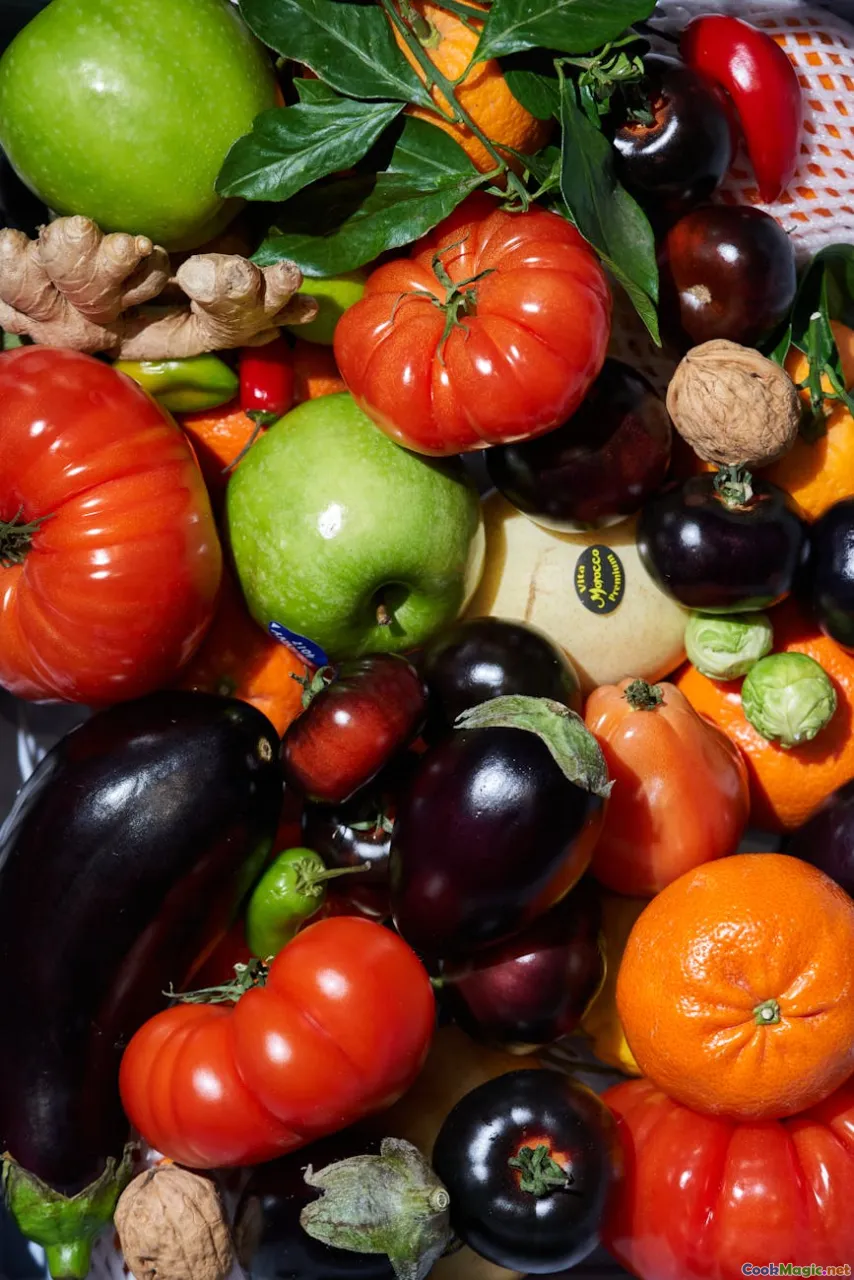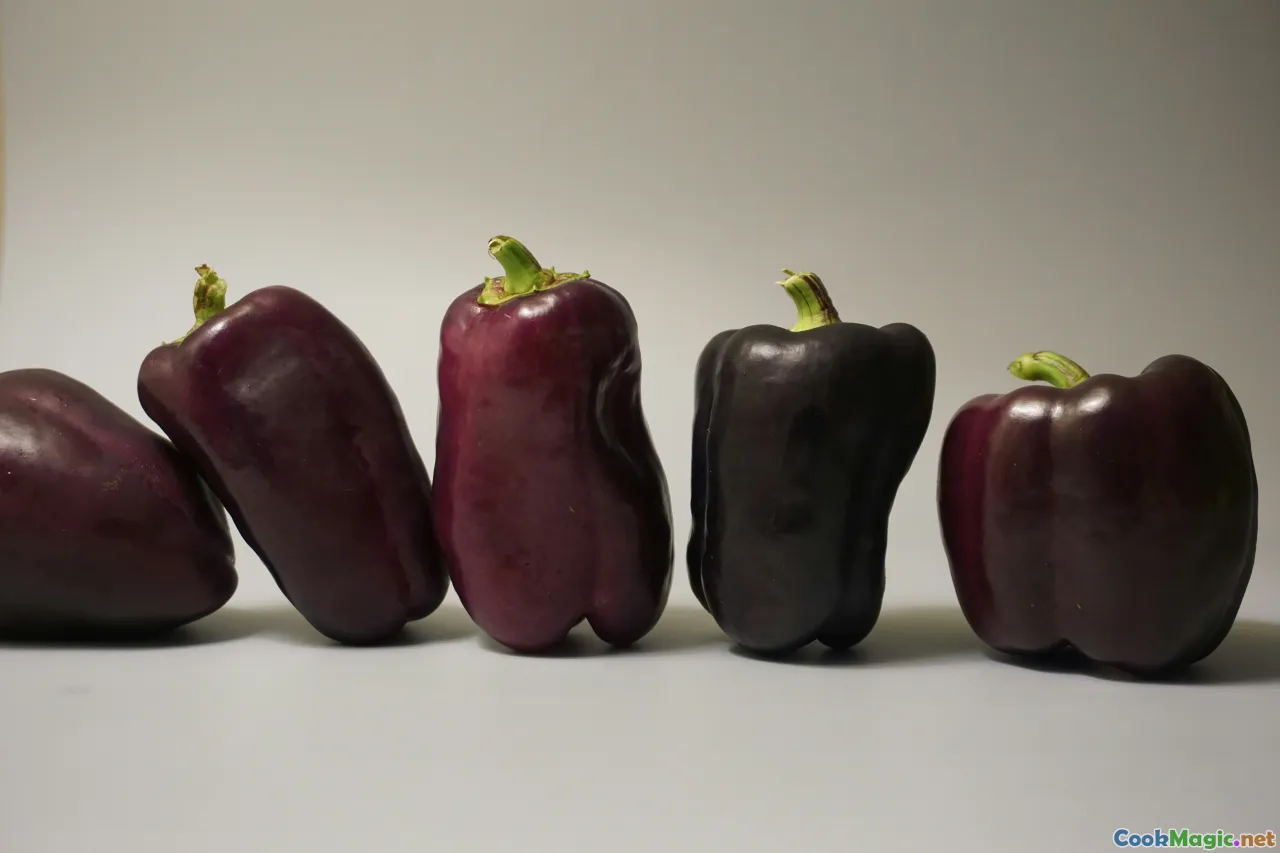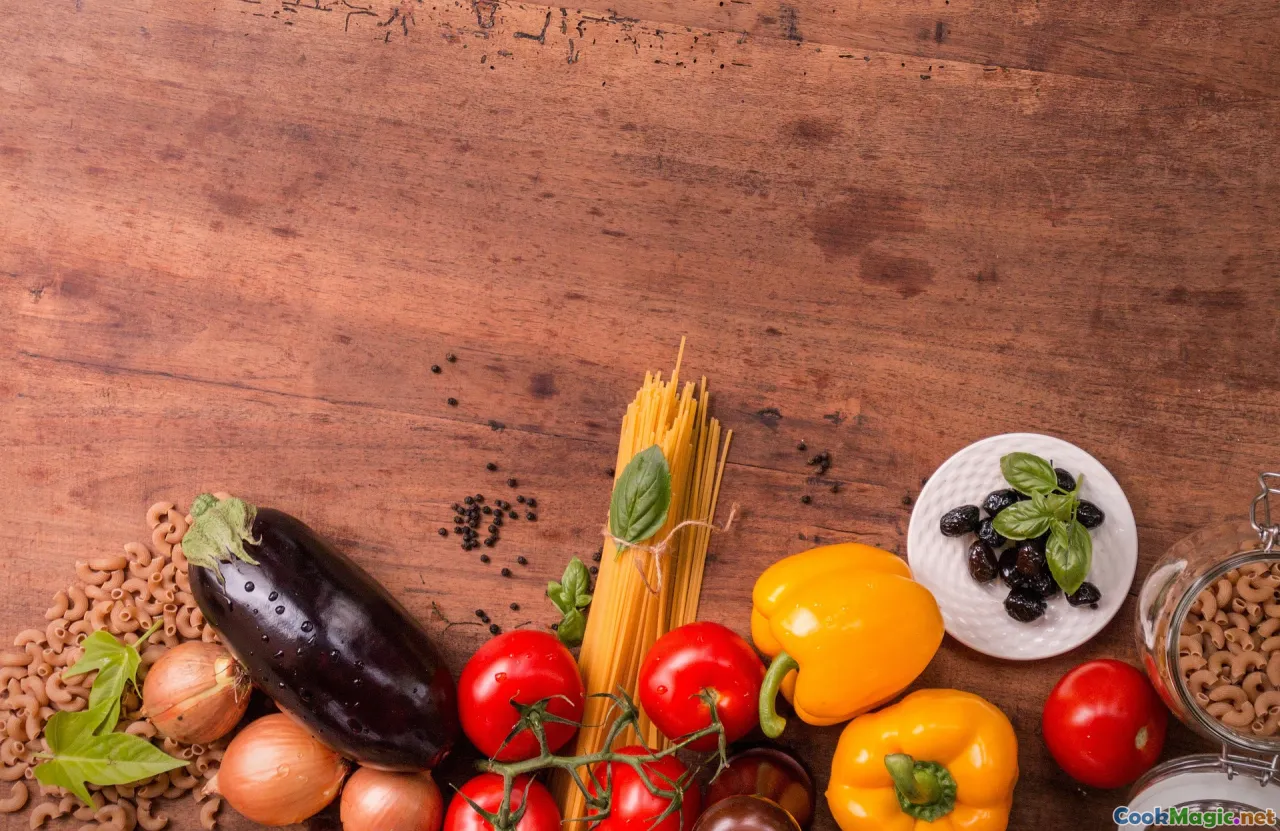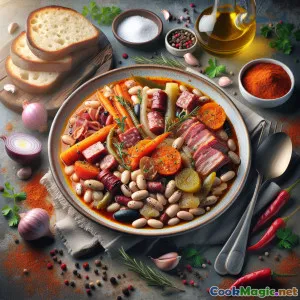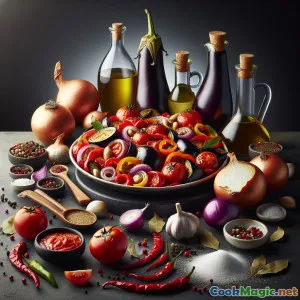
बैनेट-शैली भुने बैंगन और मिर्च की चटनी
(Banat-Style Roasted Eggplant & Pepper Spread)
(0 समीक्षाएँ)सामग्री
-
4 medium (1200 बैंगन
(about 1.2 kg total; pick glossy, firm ones)
-
5 large (900 लाल शिमला मिर्च
(about 900g; can use kapia peppers for more sweetness)
-
4 medium (500 पके टमाटर
(about 500g, peeled and chopped, extra ripe preferred)
-
3 medium (300 प्याज
(about 300g, yellow or red, finely chopped)
-
125 ml सूरजमुखी का तेल
(neutral oil preferred for authenticity)
-
3 cloves लहसुन
(बारीक कटा हुआ)
-
2 pieces तेज पत्ते
(adds traditional aroma, remove after cooking)
-
1/2 tsp काली मिर्च
(ताज़ा पिसा हुआ)
-
1 tbsp नमक
(स्वादानुसार)
-
1 tsp चीनी
(balances acidity, optional but recommended)
(about 1.2 kg total; pick glossy, firm ones)
(about 900g; can use kapia peppers for more sweetness)
(about 500g, peeled and chopped, extra ripe preferred)
(about 300g, yellow or red, finely chopped)
(neutral oil preferred for authenticity)
(बारीक कटा हुआ)
(adds traditional aroma, remove after cooking)
(ताज़ा पिसा हुआ)
(स्वादानुसार)
(balances acidity, optional but recommended)
पोषण
- परोसने की संख्या: 6
- सेवा आकार: 1 small jar (~200g)
- Calories: 120 kcal
- Carbohydrates: 0 g
- Protein: 2 g
- Fat: 7 g
- Fiber: 4 g
- Sugar: 8 g
- Sodium: 650 mg
- Cholesterol: 0 mg
- Calcium: 30 mg
- Iron: 1.2 mg
निर्देश
-
1 - Roast Vegetables:
Roast eggplants and peppers, whole, either on a grill, over an open flame, or in a hot oven (220°C/425°F) until skin blackens and flesh is soft. Turn frequently.
-
2 - Steam & Peel:
Transfer roasted vegetables into a covered bowl or sealed bag for 10-15 minutes—this helps steam and loosen skins. Peel off all charred skin while still warm, remove pepper seeds, and drain eggplants well.
-
3 - Chop Ingredients:
Finely chop peeled eggplants and roasted peppers. Optionally mash with a wooden spoon or pulsing in a food processor (do not over-purée). Set aside.
-
4 - Sauté Onions:
Heat sunflower oil in a large pot on medium. Add chopped onions, cooking until soft and golden but not brown (about 8-10 minutes). Stir in garlic (if using) and sauté 1 more minute.
-
5 - Simmer Sauce:
Add peeled, chopped tomatoes to the pot. Cook until sauces thickens and tomatoes break down, stirring frequently (10-15 minutes).
-
6 - Combine & Cook:
Stir in chopped eggplants, peppers, bay leaf, salt, pepper, and sugar. Lower heat and simmer gently, uncovered, stirring often so it doesn’t burn, until thick and glossy (30-40 minutes). Remove bay leaves.
-
7 - Jar or Serve:
Taste and adjust salt. Serve warm or cold, or transfer into sterilized jars. For canning, ladle hot zacuscă, seal, and process as appropriate to preserve.
Roast eggplants and peppers, whole, either on a grill, over an open flame, or in a hot oven (220°C/425°F) until skin blackens and flesh is soft. Turn frequently.
Transfer roasted vegetables into a covered bowl or sealed bag for 10-15 minutes—this helps steam and loosen skins. Peel off all charred skin while still warm, remove pepper seeds, and drain eggplants well.
Finely chop peeled eggplants and roasted peppers. Optionally mash with a wooden spoon or pulsing in a food processor (do not over-purée). Set aside.
Heat sunflower oil in a large pot on medium. Add chopped onions, cooking until soft and golden but not brown (about 8-10 minutes). Stir in garlic (if using) and sauté 1 more minute.
Add peeled, chopped tomatoes to the pot. Cook until sauces thickens and tomatoes break down, stirring frequently (10-15 minutes).
Stir in chopped eggplants, peppers, bay leaf, salt, pepper, and sugar. Lower heat and simmer gently, uncovered, stirring often so it doesn’t burn, until thick and glossy (30-40 minutes). Remove bay leaves.
Taste and adjust salt. Serve warm or cold, or transfer into sterilized jars. For canning, ladle hot zacuscă, seal, and process as appropriate to preserve.
बैनेट-शैली भुने बैंगन और मिर्च की चटनी :के बारे में ज़्यादा जानकारी
Zacuscă de Vinete cu Ardei Copți Bănățeană – Honoring Banat‟s Heartfelt Cuisine
Banat, a region at Romania’s western edge, is a distinctive culinary crossroads, merging bubbles of Slavic, Hungarian, Serbian, and local Romanian heritage. "Zacuscă de vinete cu ardei copți," especially the Banat interpretation, represents not only autumn abundance but the gentle, slow food approach echoing across generations.
What is Zacuscă?
Zacuscă is a beloved vegetable spread present in every Romanian household, especially in the fall. Its basic composition merges roasted eggplant, roasted peppers (kapia or bell), onions, and tomatoes, simmered long and slow in sunflower oil. In Banat, the emphasis is on layered flavors—achieved by deeply roasting each vegetable before combining, and an extra measure of peppers for sweetness and color.
Traditionally, homemade zacuscă is prepared in generous batch es on late August or September weekends. The family gathers for an epic late-harvest ritual: everyone partakes, from roasting veggies over burning wood (an essential signature for smoky notes) to peeling, chopping, and stirring the slowly-thickening cauldron.
A Cultural Mainstay
Romania’s food preservation practices are guided by the need for flavorful, nutritious, convenient food in winter months. Zacuscă, seasoned and bottled in beautiful jars, is pantry gold—used through cold seasons at every picnic, roadside snack, or festive grazing table. It’s served at room temperature as a spread atop sourdough bread, sleek with oil and glistening colors, sometimes accompanied by pickles, cheese, or tomatoes in the summer.
In Banat, families are known for slightly increasing the pepper ratio and incorporating sweet red varieties brought in by both Serbian and Hungarian influences, thus the unique flavor that leans both toward smoky and sweet. Muslim and Orthodox Romani and Serb communities in Banat share in the tradition, and recipes are lovingly traded between neighbors irrespective of background. Every artist’s signature? Varies—from the coarseness of the chop to touches of garlic, or late additions of sugar for balance.
Tips for Authentic Success
- Roast with patience: Open flame or hot grill gives unforgettable flavor, just be careful not to dry out the eggplants.
- Peel while warm: The key for a smooth, bitter-free puree is meticulous peeling.
- Drain roasted eggplant: Removing excess liquid is crucial for unctuous yet spreadable zacuscă.
- Simmer low and slow: Time lets flavors intertwine—at least half an hour after mixing in the vegetables.
- Taste & Adjust: Some like a sweeter result, while others prefer robust smokiness. Garlic highlights relish notes; skip it for pure traditionalism.
The Joys of Keeping and Sharing
This recipe is vegan and gluten-free without effort. Zacuscă lends itself to improvisation; use it as a dip, sandwich spread, or pasta base. If you managed to jar some, be sure jars are thoroughly sterilized and sealed immediately while hot to avoid spoilage—many home cooks rely on water-bath canning for security.
This dish is an exemplary ambassador for Romanian hospitality—its preparation labor-intensive, its yield immense hospitality. Slicing into a sunny autumn afternoon, sipping local white wine, with hearty, red-speckled zacuscă atop a rye or rustic loaf, best conjures the lush seasons and rich, overlapping histories shaping Banat‟s unique table.
Suggested Pairings & Personal Touches
Try pairing with feta or telemea for a punch of salinity or alongside tangy murături (pickles) in true Banat style. I enjoy folding chopped, fresh parsley into my jar of reserved zacuscă for herbal vibrancy.
If sharing this vibrant spread with friends, recount the story of families elbow-deep in eggplants by the fireside—it animates just how meaningful this simple, robust dish remains. It’s both sustenance and heritage: comfort in every bite. Bon appétit—or as locals say, "Poftă bună!"

